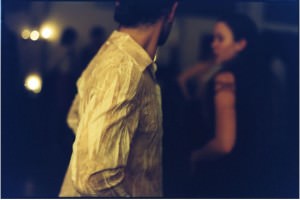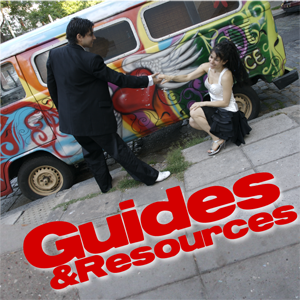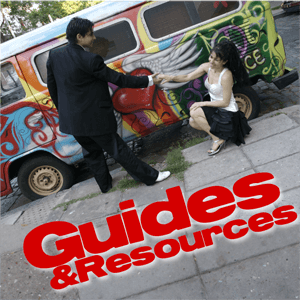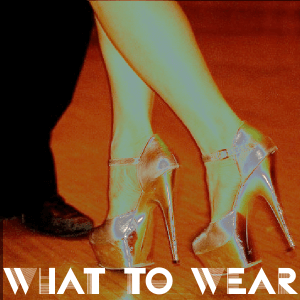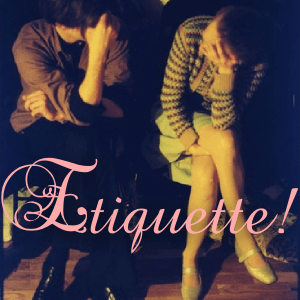Index
Who initiates a dance?
The leader’s job is to create art. S/he needs to feel moved by the music, the follower, and the moment in order to do this. Otherwise it’s like commissioned artwork, which sours the experience of creativity and generally produces lesser work. When a follower asks a leader to dance they are commissioning work, and it’s not going to have the inspiration that the dance will have it comes from the leader’s own vision and desire!
Moreover, tango is a pretty intense experience, so it should be totally consensual. The cabeceo (see next entry) is a good way to create consensuality in cultures where people don’t feel comfortable being so confrontational as to turn someone down verbally.
About women’s power in this situation.
How can I invite someone to dance?
The purpose of the Argentine custom, known as the “cabeceo”, is to protect the ego. It makes the invitation to dance less stressful and the possibility to decline more discrete. Essentially you can avoid receiving or having to say a harsh verbal “No”. It spares everybody’s feelings. To make the cabeceo, dancers use eye contact. Followers may smile encouragingly. If eye contact is held, a leader makes a small gesture, nodding their head toward the dance floor or raising an eyebrow or both (it’s a matter of personal style). The follower accepts the invitation by smiling and nodding agreement. The leader may come to fetch the follower from their seat, or the two may meet on the dance floor.
If the follower does not want to accept the dance, they break eye contact. If a follower does not want to dance with a certain person, the follower is careful not to make eye contact with them. If a follower does not feel like dancing at all, they communicate unavailability by not making eyes available. They can watch the dancers or have a conversation.
If a leader tries hard and is unable to catch a particular person’s eye, or if they avert their eyes as if they didn’t actually see you, that person is unavailable to dance with you right now. (Maybe forever. It’s their choice.)
If you don’t succeed in catching a person’s eye and eliciting a smile, please don’t resort to tapping somebody’s shoulder, extending your hand toward them, or even positioning yourself squarely in front of a person so they can’t avoid looking at you. It is considered very rude. If you see two people with their heads together, as in the photo above, they are not available to dance with you. If you want to dance with someone who is hanging out with someone they are romantically involved with, it’s best to acknowledge the partner as part of your invitation to dance. You can shake hands, kiss hello, or nod reassurance that you will respect their relationship.
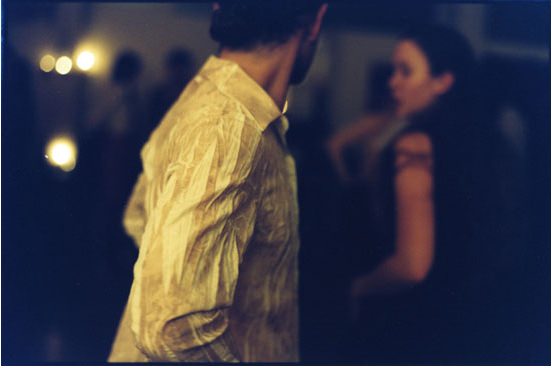
Some dancers do not know or do not use the cabeceo. As a result, leaders walk up to followers and ask them verbally. Because we want to avoid making a public rejection, followers usually accept. Obviously the new people don’t know about this way of inviting people to dance. It’s ok to ask for and accept dances verbally. If someone asks you without using it, please make sure they know what it is and how to use it. You should expect them to use it in the future, and don’t feel bad turning them down if they don’t.
Once a cabeceo has been accepted you have a contract to dance the next song with each other. No matter what happens, you cannot change direction and dance with another partner. Even if someone stops to talk with you, you need to hustle to your partner. (Everyone understands this, so it’s not considered rude not to stop to talk.)
Queer tango cabeceo
Two leaders get eye contact: It’s very possible that two people who both want to lead the next song try to ask each other to dance! In this case, after one gives the nod, the other should reject it (by looking away), unless s/he decides they want to follow. If you accept another’s cabeceo, you are accepting to follow. If things get confusing, and you’re willing to go either way, let your partner step onto the dance floor first. If it looks like you’ll be walking backward in the line of dance, you’re following.
Two followers get eye contact. Stare as long as you like, but no one will nod. You’ll probably figure out what’s going on. If a follower is so desperate to dance that s/he waggles a body part toward the dance floor, s/he better be ready to lead.
How can I avoid dancing (with someone specific, or at all)
If you prefer not to dance at this time, avoid catching someone’s eye. If the eye contact avoidance does not have the desired effect and someone resorts to the shoulder tap method, it’s OK to just say no. If you decline a verbal invitation to dance from somebody you generally like to dance with except just not right then, it is expedient to come up with an excuse such as “sorry, I really need a break right now”, “thanks, but I already promised the next set to …”, or “thanks but not right now, my feet hurt”. Obviously if you use fatigue or painful feet as an excuse, you should wait a little bit before leaping onto the floor with somebody else, or the excuse won’t look genuine.
What if some person just won’t dance with me?
Certain people will never dance with certain people. Don’t take it personally or get worked up over it, please. Nobody has an obligation to dance with everybody. It’s very much a consensual privilege and not a moral duty. To get more dances with more people, try introducing yourself, being friendly, saying hello to everybody, and working hard on your technique.
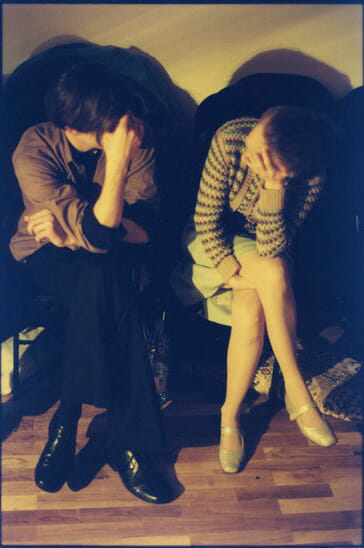
Who should I expect to dance with?
Beginning and intermediate leaders should dance with followers at or below their level. You assess this by watching the dancers. Followers with very tidy footwork who never miss a step are advanced. Followers who look more awkward and seem to falter or take extra steps are newer.
Beginning leaders benefit from dancing with more experienced followers. This should be done at practicas. More advanced followers “invest” in new leaders and will accept occasional dances with beginning leaders, and may even “adopt” a few (but not all) beginning leaders in their community. This means they may regularly (once per evening, at practicas and milongas) accept a tanda with these leaders.
However, most of a beginning leader’s dances should be with people at their own level. A beginner should never expect an advanced dancer to dance more than one tanda. In the case of a very very beginning dancer, an advanced follower may excuse themselves earlier, but don’t be discouraged. It can be a lot of work to follow a beginning dancer.
Beginning followers will be easily spoiled by their first few dances with advanced dancers. It’s easy to follow an advanced dancer and it makes a follower feel confident in their skills. But the real challenge for a follower is dancing with a less skilled leader. A good follower can enjoy dancing with a beginner and make the dance wonderful, just as a good leader does. Dancing with less skilled leaders is an opportunity to work on following technique.
For intermediate and advanced dancers, Mitra recommends a ratio of 3:1. At minimum, one of every four tandas should be with someone below your level. This applies to leaders and followers.
Milongas and practicas
Social dance events are called “milongas”. It’s like a party or dance night. Usually it is at the same place every week (some are once a month). Every city has a website announcing the milongas. Usually there is a fee at the door (around $10) for 4 or 5 hours of dancing. Some people dress up, others dress very casually. The milonga is a space in which you are welcome to express yourself flamboyantly with your clothing and dress * sexy *.
We recommend that beginners attend a milonga along with a group of friends to make sure that you have people to dance with.
(Note that ‘milonga’ also has a second meaning, which is the fastest of the three types of tango music.)
Practicas are an informal milonga. There is a DJ to play music and people show up to practice with whoever is there. In some cities, people dress much more casually for a practica, the lights are usually on, and it is cheaper ($5). Some people come with a partner and do not change partners. Many people come alone, in order to practice with various people. Some people change partners after the tanda, others may dance together for a long time. It is more flexible than a milonga.
Unlike at a milonga, it’s ok to stop during the song and ask questions and practice a move over and over. People are free to try new things, work on specific moves, or ask friends to show them things.
It is very inappropriate to start critiquing or correcting your dance partner’s technique at a Milonga. At a Practica it is OK to give feedback, but you should probably ask if your partner wants it before giving it. Some people enjoy taking tips from other dancers, others prefer to stick with the advice and progression of lessons of their main teacher.
Some practicas are treated by some dancers as Milongas. Although some people are dressed informally and are practicing and talking about moves, they may dress up, use the cabeceo, and just dance. That’s fine, but they must not get annoyed when dancers are stopped in the dance floor working on a move.
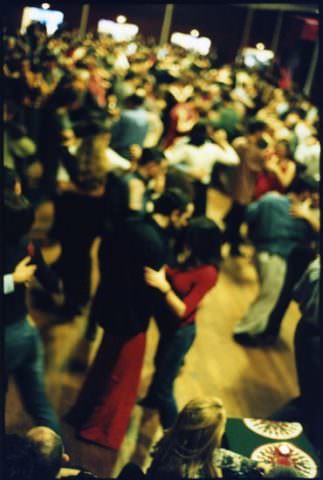
Alcohol
Although some milongas serve wine and some dancers do drink, you are disqualified from dancing if you have drunk enough to be affected at all. This dance is too difficult to try without your full skills. If you feel like drinking tonight, just enjoy watching and talking.
Tango music is played in tandas
At most milongas, the DJ will play music in sets (called tandas) of 3 or 4 songs by the same orchestra from the same period. The number of songs in the tanda varies by the kind of music. Milonga (the fast one) and vals are is sometimes played in sets of 3 songs per tanda. Tango songs are played in tandas of 4 songs. Generally you will hear 2 tandas of tangos, then 1 tanda of valses, 2 tandas of tangos, and 1 tanda of milongas, in repeating cycles. A variation on this, which you may hear early in the evening, is 1 tango tanda, 1 vals tanda, 1 tango tanda, 1 milonga tanda, 1 tango tanda, a few alternative or neotango songs, and all over again. You can turn this predictability to your advantage by planning ahead so you can find your favorite milonga partner when you know there’s a milonga set coming soon.
Not all DJs stick to this rotation.
At neotango milongas, DJs often do not play tandas or cortinas. They may play a “wave” which is 30-90 minutes of music without any pause, the songs fading in and out of one another. In this case, you will need to politely inform your partner when you are tired of dancing.
Live music
Dancing to a live ochestra is very special because leaders do not know how familiar songs will be played. This enlivens their dancing. Live orchestras may not play tandas, and may play only one milonga. This makes changing partners a bit chaotic, so be good humoured about it.
When a live orchestra plays for dancers, it is customary that the dancers show respect and appreciation to the musicians by listening and NOT dancing for the duration of the first song.
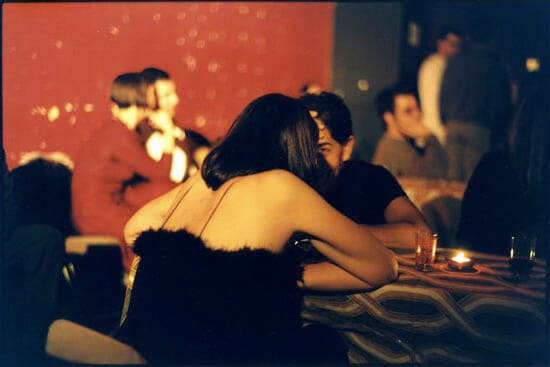
Chatting while dancing
Some people like to concentrate on the dancing while others chatter constantly. If you are one of the former, it’s perfectly OK to say “sorry, I find it hard to talk and dance.” In general both conversation and dancing improve when not done simultaneously.
What to do in between songs
In between songs, you can let go of your partner; it feels a little odd to remain locked in the embrace when there is no music. Also you want to wait for the next song to start before resuming the embrace. Some leaders do like to stay in the embrace, and that’s ok too. The follower should not hang on if the leader is letting go. Often people introduce themselves or just chat. Don’t be surprised if your dance partner does not introduce themselves now, or ever. It’s not considered necessary or important to the dance, although a lot of US people do it anyway. If you enjoyed the dance you may be tempted to say “Thank you”. These words will be interpreted as “I’m done dancing with you and I will now return to my seat”, so they should be saved for the end of the tanda. Instead, say something pleasant like “that was nice” or make a friendly comment about their dancing style.
What to do during cortinas
At milongas, the DJ will often play a cortina between tandas. A cortina is a short piece (about 30 seconds) of non-tango music that tells the dancers this tanda is over and a new tanda is about to begin. The next tanda will be a different style of music and is often, but not necessarily, danced with a new partner.
blogpost on rethinking cortinas.
Ending the series of dances with this partner or When and how to stop?
If one of the partners says “Thank You” at the end of a song, the other one responds in the same way and both move off the floor. It is customary to dance 3-4 dances with the same person before saying the magic phrase “thank you” and moving on. This is the standard way of doing things and nobody will think anything of it, especially if you say something nice like “thank you, that was lovely”, or “thank you, I need a little break, let’s dance again later”, etc. If you drop a person before 3 dances, it will convey the message that you don’t enjoy dancing with them, and it should be done only if your inconvenience or impatience outweighs the rudeness you convey. People sometimes dance more than one tanda, perhaps 2 sets or even 3. A good way to ease in the end is to ask your partner if they want to dance “one more”, and then the expectation is to part after the end of the next song. You still need to say Thank You.

What if we’re having so much fun we don’t want to stop?
If neither person says thank you and moves on, likely you will continue dancing with each other. If there happens to be a gender imbalance, maybe you want to show community spirit and give your friends a chance to dance with your partner. Of course none of this applies to dancing with your significant other or your special date. If there’s romance going on, or some other variation on lust, nobody can reasonably object to you being all over each other the whole night.
Interrupting people while they are dancing.
Very simple. Don’t. Not even to say hello when you arrive or leave. If you must acknowledge someone, a quick nod is the maximum. Your dance partner deserves your undivided attention. If you have some urgent need for information exchange, at least wait until a moment between songs, and keep it very brief.
What if a dance is an intolerable ordeal?
Generally, once we have agreed to dance, we complete the tanda (or three or four dances) with that person. It is considered rude not to complete the tanda. We do not break the tanda because of the person’s dancing skill. Generally, sweatiness and other discomforts that are simply a result of being close to another person is accepted in tango, and we do not break a tanda for these kinds of discomforts.
There are, however, times when we do break the tanda despite the fact it is rude. That would be: if the person is running into people (or furniture) a lot and you feel unsafe or unprotected dancing with them; if they are groping you or making you very uncomfortable in a way that is not part of the common tango embrace; if they are too drunk to dance.
Short of these rare situations, tolerate the situation with grace. Whatever you do, try not to frown too obviously and by all means don’t roll your eyes or make faces at your friends. Other potential partners will notice your rudeness and are sure to wonder if you do the same thing while dancing with them. Try closing your eyes or putting on your patient face until the ordeal is over.
One special case of leaving a partner on the dance floor.
There is one (and only one) routine situation in which a person will break the contract to dance with a partner or even break a tanda. Dancers with partners or girl/boy/friends almost always dance the last tanda of the evening together. If somehow they weren’t aware that the last tanda had begun, when they hear the music of the last song (which is always the same song, La Cumparcita) they should find each other for that last song. Everyone respects this custom and releases a dancer with enthusiasm to join their partner. So if you have just stepped onto the dance floor with a new partner and the DJ announces it is the “last tanda of the evening” you should not be surprised or upset if they excuse themselves. If you are dancing with someone who you know has a partner, you should encourage them to leave you if they wish. There is no embarrassment in being left in this way because it is a ritual which everyone supports.
The cumparsita is sacred for a reason: You don’t just come back to each other. You let go of others. You choose each other in the very face of temptation. You bring yourself back to your chosen relationship, away from spontaneous fantasies of flirtation. Fellow dancers should always encourage their friends back to their partners at this moment. You don’t just go home together. First you give each other the best of what you have been giving to other people.
Traffic and Collisions
Please move around the dance floor in a counterclockwise direction and at the same speed as the other dancers.
Tango dance floors have lanes. Pick one and stay in it. Don’t overtake, speed, zigzag or cut people off. The easiest one to stay in is in the outer lane. Try to move at the same speed as other dancers. If there is a lot of space ahead of you, that means there is a traffic jam behind you, in this case please move on and give the other dancers space. Dancers have absolute right of way on the dance floor. Pedestrians are advised not to walk or loiter on the dance floor when not dancing.
Leaders should always protect their follower from impacts. this is always more important than completing your planned move.
If you do bump into someone, you should apologize, if not because you caused the collision, then because you failed to avoid it. The apology can be accomplished verbally or by making eye contact. Road rage is unacceptable. If some furniture bumps into you, you should apologize to your follower and make sure s/he’s OK.
Emotions
Close embrace tango involves touching another person with half or more of your body. This is very intimate. The codigos of tango are a set of “codes” that make some protective structure around this intimacy. The codes vary a little bit from milonga to milonga, city to city. We have not found a comprehensive list of the codigos in English. Although the codes are highly gendered, much of their intent is also relevant to queer people. Eventually a new set of codes will develop that incorporate the complexities and ambiguities that queer tango introduces.
Maintain the tango embrace. Any feelings you have during the dance are expressed outwardly only through the quality of your dance. You do not express your enjoyment of the dance by sliding your hand to your partner’s ass, neck, breast, etc. This is a violation of the trust they give you when they dance with you. It also could make a problem for them with their partner if they have one, and that is very disrespectful. It is common in tango to make contact with your head or cheek, but make sure if you do this that it is consensual. If you feel the other person pull away, respect their wishes not to connect in this way. It is not necessary for the dance. Also understand that many dancers are very accustomed to this contact. If you dance with someone who persists in doing it, do not be offended. It is not an inappropriate gesture.
Whatever you feel during a dance, know that it ends when you finish your dance. When the tanda ends, say thank you, and walk away. As you walk away, the feelings must end. You are not welcome to “hang out” with the person just because you had a good dance. You are not welcome to have a “special” relationship with them, as this could cause problems for them with their partner, if they have one, or it could make awkwardness that will disrupt your ability to enjoy future dances. Remember, protecting your own and others’ access to the dance is the top priority!
We do not give last names and we do not ask personal questions in tango. It is a space of anonymity. This also means that tango is an escape from class status issues. Everyone interacts as equals. (In some communities, because people don’t know better they will ask “what do you do?” Feel free to say “I don’t want to talk about that” or change the subject to a tango-related issue like “why did you start dancing?”)
In order to feel safe with the intimacy of tango, it needs to be a social space in which people feel protected from romantic advances. For this reason, it is not appropriate to ask someone for their phone number, or ask them on a date. Of course this does occur, but it needs to be discreet. Perhaps get to know them for a while first, before asking. (At the same time we need to build community, so we can go out dancing together as a group — particularly queer dancers. Make it clear what you are up to!)
If you are asking someone to dance who has a partner, greet the partner first and ask, either verbally or with a gesture, for their permission to ask their partner to dance. This does not mean you are treating someone as if they are the property of another person. It means that you are letting the partner know that you will respect their relationship during the dance. If you have made the cabeceo with someone who is sitting with their partner, they should stay in their seat and you should approach them and greet/shake hands with the partner before heading off to dance. You do not need to exchange names, the handshake is the important part.
More on managing emotions in tango.
How to be a good man as you become an advanced tanguero

Personal hygiene
Generally, sweatiness and other discomforts that are simply a result of being close to another person are accepted in tango, and we do not break a tanda for these kinds of discomforts, nor do we comment upon them to the person or others. Please be clean and wear clean clothes. If you wear perfume or cologne, keep in mind that your dance partners may not want to end up wearing it too. Also recall that people will have their faces near your neck so they are going to get a heavy dose anyway. Be sparing. (When we did a survey of how to advise dancers how to be attractive to partners, the #1 request from men and women was “less perfume/cologne!”)
Use breath mints or gum, particularly if you haven’t had time to brush your teeth immediately before the class or dance. You are going to be breathing into other people’s faces.
Photography
Tango is a bit private. Feel free to tell photographers that you don’t want your photo taken or that they may not post or use it without your permission. If you want to photograph dancers, ask the organizers to let you make an announcement at the appropriate time so that people will know how you intend to use the photos, how they can contact you, etc. Build trust with dancers by being selective with the photos you post (make sure everybody looks great!). Finally, respect dancers’ privacy and the intimacy and delicacy of tango.
Take classes
It is rude and inconsiderate to expect the more experienced dancers to teach you what you need to know one-on-one on their own precious dancing time. There is no excuse for not taking a class. The practica is a place to practice what you learn in a class. If you show a continued commitment to work and improve and try to make the dance as interesting an experience for your partner as for yourself, everybody will always be happy to practice with you.
Teaching
If you don’t know technique perfectly, you are not qualified to teach. Please refer the beginners to a class or recommend that they speak with a more experienced dancer.
Recruitment and being nice to new people
Please be nice and welcoming to new people. If a new face stops in to watch the dancing, and you are not dancing please don’t ignore them longer than a minute or two. You could greet them, tell them who we are and what we do, give them fliers or information about classes and in general be very welcoming.
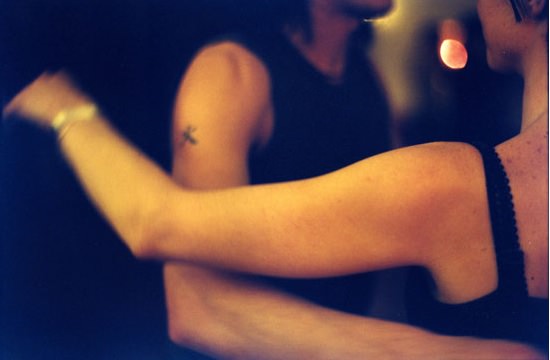
Dancing with beginners and offering advice
Please take a beginner for a spin. Be encouraging and build their confidence. Remember you were a beginner once too. If the experienced dancers spent time on you and as a result you are still around and not a beginner anymore, that means it’s Payback Time.
Just dancing with the beginners is a good thing. Additionally you may feel the urge to explain things and offer helpful friendly advice. Please don’t just flatly state they are doing Everything All Wrong. Instead, ask “May I offer a suggestion for a more effective way to do this/ a suggestion to improve this etc”. Don’t argue. Whatever you do, don’t do anything that’ll make the beginner feel more inadequate than is already the case.
Finally, it is well-known that dancing well with a total beginner is a skill that distinguishes an advanced dancer from an intermediate one. You have seen advanced leaders lead beginners through steps they never knew they could do. Advanced followers move so lightly and easily that beginners can make them follow steps they’ve just learned and that won’t yet work on other dancers. Remember that if a beginner messes up, it is not exclusively their fault and you would do well to be patient.
Cultural maintenance: educating the new people
Beginners don’t know these things so please take the opportunity to briefly explain to them:
- How to invite somebody to dance with the cabeceo
- “Thank you” means it’s over
- Tandas and cortinas
- Three types of music
This Guide was originally written by Tina Herreman.
It was edited, formatted, and queerified by Duro y Vio.
Photos with permission by Romain Baillon.

Blog posts about
the codigos, cabeceo,
emotions, and etiquette

In Defense of etiquette 2023: Part I: Codigos

In defense of etiquette: Part II: Cabeceo

No means no

Pleasures of the Cabeceo

Hugs and Laughter
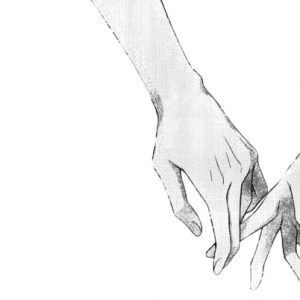
How to be a Good Man, as you become an Advanced Tanguero

How to become a Hot TangoMan

The codigos (advanced)

Why I don’t ask Marks to dance…

The deeper cabeceo
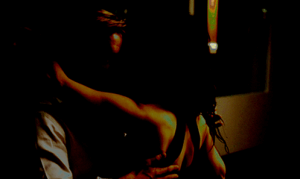
Emotions on the dance floor
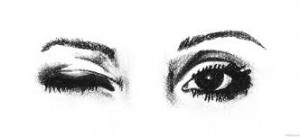
The reverse cabeceo

Rethinking cortinas

The power of desire
